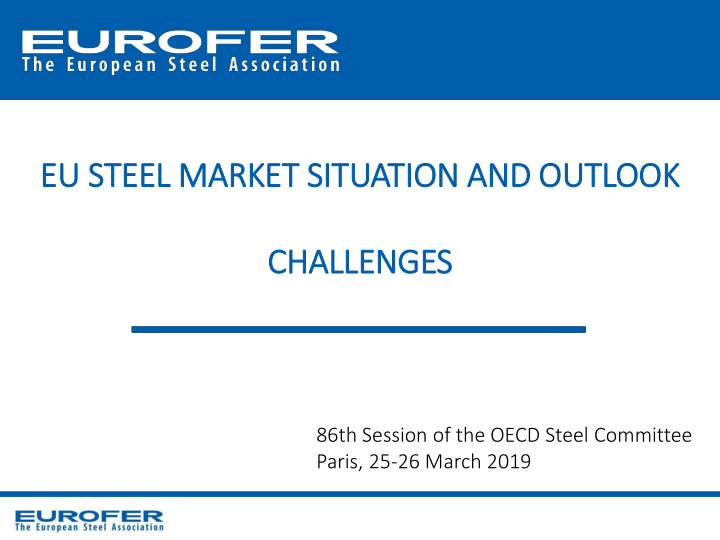



EU STEEL MARKET SITUATION AND OUTLOOK CHALLENGES 86th Session of the OECD Steel Committee Paris, 25-26 March 2019
STEEL USING SECTORS M ANUFACTURING LOOKS FRAGILE AS ORDER BACKLOGS GET DEPLETED 2 Slide | 2
STEEL USING SECTORS C ONSTRUCTION SECTOR • strong performance in 2018 (+4,8%) • broad-based rebound across countries and subsectors • construction sector fundamentals expected to remain mildly positive • positive but slowing support from residential and non-residential building demand going forward • civil engineering activity supported by projects geared at improving bottlenecks in EU’s infrastructure • output growth 2019: 2.1%, 2020: 1.2% 3 Slide | 3
STEEL USING SECTORS A UTOMOTIVE SECTOR : STUCK IN LOW GEAR • Since September 2018 car sales on a falling trend • All major markets affected • Commercial vehicle demand also losing momentum • Exports on a downward trend • Production activity edged lower in H2-2018 • Total output grew 1.3% in 2018 • Passenger car and CV demand to moderate further in 2019-2020 • Trade is major uncertainty • Outlook rather subdued • EU manufacturers announced job cuts and cost saving plans • Output to grow 1% in 2019, followed by 2.4% in 2020 Slide | 4 4
EU STEEL MARKET I MPORTS FLOOD EU MARKET IN 2018 Situation H2-2018 • Apparent steel consumption rose by 1.4% y-o-y (H1: 3.7%) • Imports rose much more strongly: +15.3% y-o-y (H1: 9.8%) in spite of preliminary safeguards • EU domestic supplies fell by -2.5% y-o-y (H1: +3.5%) • Share imports in apparent steel consumption reached 25% in Q4-2018 • The 2.6% rise in steel demand in 2018 benefitted mostly 3rd country suppliers with imports rising by 12.3% Outlook 2019 and 2020 • apparent consumption forecast to increase by only 0.5% in 2019 followed by 1.2% in 2020 Slide | 5
EU STEEL TRADE 2018 IMPORTS BY COUNTRY OF ORIGIN top 5 c ountries of origin represented 65% • of total imports in 2018 • Turkey alone accounted for 21% of total EU imports (65% rise); by contrast, total exports Turkey to other countries rose by less than 5%; 42% of total finished exports from Turkey ended up in the EU (71% flat products) • imports from Russia, Taiwan and Serbia also rose strongly; imports from China, India, Brazil and Ukraine were lower than in 2017 • due to the rise in imports and a drop by - 11% in exports, the EU trade deficit deepened in 2018 to almost 17 million tonnes (2017: 10 mt) Slide | 6
EU STEEL TRADE NEED FOR STABILISATION OF TRADE FLOWS EU STEEL SAFEGUARD: 26 SFG categories - cumulated imports evolution : 2018 vs 2017 (tonnes) 4.000.000 • Global overcapacity, trade 3.230.363 3.500.000 3.000.000 3.031.698 protection measures adopted by 2.500.000 2.672.794 2.000.000 third countries, U.S. Section 232 2.039.673 1.807.090 1.500.000 1.691.912 759.655 1.000.000 measures 1.174.319 327.288 351.107 377.470 500.000 764.556 Deflection: 71% 11.998 • 0 Further increasing imports 165.309 -1.078 -94.640 -160.250 -500.000 -1.006.030 threaten to disrupt (again) the EU -1.000.000 -1.651.305 -1.500.000 -2.023.151 market -2.000.000 US -2.593.398 -2.500.000 EU • -3.071.710 Anticipating trade diversion from -3.000.000 -3.277.935 -3.500.000 -3.447.504 U.S. Section 232 measures at the -4.000.000 same time ensuring the traditional trade flows maintained (tariff-rate quota) Jan-May Jun-Dec • Concern of accelerated 18 vs 17 18 vs 17 speculative quota use by certain US Imports 0% -22% exporters causing market- EU imports 5% 15% destabilising stockbuilding Source: EU COMEXT , U.S. Census Product scope: 28 finished steel product categories EU provisional steel safeguard Slide | 7
CONCLUSIONS AND MESSAGES EU Steel Market and Trade • EU steel demand conditions significantly weakened (close to zero growth in 2019) • Market supply by imports outpacing domestic supply – record import market share finished products (25% Q4 2018) • H2 2018 imports continued to surge (+18% y-o-y) notwithstanding the introduction of provisional safeguard measures in July • Exports continue declining (-11% 2018) Challenges and Messages • U.S. Section 232: Trade deflection towards the EU market is a reality, impacting directly EU steel exports to the US and indirectly third country exports targeting the EU • EU steel safeguard is a timely, balanced anticipation to intensification of steel protectionism in a context of persisting high excess steel capacities. It is designed to maintain historically high imports including a generous exemption list of self-declaring “developing countries “ • Raw materials export restrictions continue to be a major distortion in the global steel sector (Indonesia nickel export restriction supporting massive stainless steel export- oriented capacity build-up) Slide | 8
Recommend
More recommend